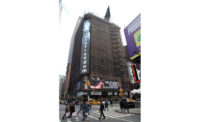New York City officials are stepping up enforcement of Local Law 10, which regulates building facades, after debris falling from a Manhattan building killed a city-based project management firm executive on Dec. 17. Industry members are calling for beefed up enforcement of existing statutes in the city and elsewhere in the U.S.
Erica Tishman, 60, an architect and vice president of Manhattan-based Zubatkin Owner Representation LLC, died after being struck by debris that fell from a brick tower at 729 Seventh Ave., near W. 49th Street in Manhattan’s midtown section. The city Dept. of Buildings (DOB) announced Dec. 30 that it would ramp up inspections, more strongly enforce Local Law 10 and add 12 new inspectors.
A larger workforce could help prevent violations that turn into fatalities, including the one last month. On April 29, the department issued a Class 1 violation after an inspector observed defects on the Seventh Ave. building’s facade and ordered the owner, an LLC controlled by Himmel + Meringoff Properties, to make repairs and implement safety measures, according to job filings. On July 24, a follow-up violation was issued to the same address for failure to resolve the citation issued in April.
At the time Tishman died, the building’s owner had filed an application for work to repair the facade, which was approved Oct. 1. However, according to the DOB, none of the planned repairs had been performed as of Dec. 17.
The owner claims in a lawsuit filed Dec. 26 that an adjacent property owner had refused to grant access for repairs.
According to DOB records, the department has issued 20 violations associated with 729 Seventh Ave. since 1988, with five in the last five years.
Citywide, the department has issued more than 87,000 violations during the last 12 months for facades, elevators, cranes, boilers and construction safety—underscoring the need for more inspectors.
“We want more close-up, hands-on inspections,” DOB Commissioner Melanie La Rocca says. She hopes the department can prevent owners from lagging in implementing remedies after they receive citations. “If we want compliance, we need to see more inspectors on the street … and removing any potential opportunities of owners not complying,” she adds.
Local Law 10, adopted in 1980 after a college freshman was killed by facade debris, requires a licensed architect or engineer to make periodic inspections of the facades of buildings that are more than six stories high. Unsafe conditions must be promptly repaired.
Going forward, La Rocca says, the owner of a building with an unsafe facade will face swifter enforcement action and undergo follow-up inspections conducted within 60 days of the most severe violation. Inspections will continue until the situation is resolved. If the owner does not make repairs or install safety measures, the city will have the work performed at the owner’s expense.
On Nov. 27, 2019, a driver in Chicago was hurt by falling wooden debris from a scaffold in the Loop downtown area. Police said the wood smashed through the vehicle’s windshield.
Law 10 was the second of its kind enacted in the U.S., following a statute passed in Chicago in 1978 after a passerby fatality. On Nov. 27, 2019, a driver in that city was hurt by falling wooden debris from a scaffold in the Loop downtown area. Police said the wood smashed through the vehicle’s windshield.
Today, “in most situations” involving exterior wall building code violations, Chicago officials will bring enforcement action against building owners in Circuit Court, says Gregg Cunningham, public information officer for the Chicago Dept. of Buildings.
The department “manages an intensive exterior wall program to ensure buildings are checked regularly and that any issues that pose hazardous or dangerous conditions to the public are immediately addressed,” he says. “While fines sometimes result from these cases, our goal is always to work with building owners to achieve compliance to ensure buildings are safe.”
Chicago filed 166 exterior wall court cases in 2019, Cunningham says. “The cases usually involve building code violations, such as facade deterioration, water tanks, balconies, catwalks, fire escapes and life safety evaluation reports,” he says.
Another related serious injury occurred in Boston in 2018, when a low-rise building’s facade collapsed on an aspiring concert pianist in the Allston neighborhood, crushing her hands.
Laws in Boston only regulate buildings taller than 70 ft. The city’s Facade Ordinance Code Section 9 requires exterior walls and appurtenances that are 70 ft tall or higher to undergo periodic inspection by a registered architect or engineer. The professional’s report must be filed to Boston’s Inspectional Services Dept. within 30 days of the inspection at a cost of $100. Failing to file would generate a $100 fine for each day the violation continues.
Boston buildings that are shorter than 125 ft may be inspected from the street with binoculars, while taller facades are required to have “a close visual inspection,” says the law. Officials considered, then rejected, mandatory inspections for buildings shorter than 70 ft after the 2018 incident.
Former city Councilor Mark Ciommo, who represented Allston until his term expired on Dec. 31 and he declined to run for reelection, says it would take “massive manpower” to inspect shorter buildings across the city. Instead, he says, the inspections agency launched “an extensive education program for owners.”
According to Ciommo, using insurance companies as a lever to pressure owners to inspect facades would be more productive. “That’s a better angle,” he says. “I’d rather do it through the private market. I think cost-effectiveness would be better that way.”
Building owners nationwide who want to learn how they can maintain safety and obey local statutes can look at engineering firm WJE's online tool called FacadeOrdinance.com, created "several years ago as a service to others that contains general information regarding facade ordinances in various cities throughout the United States," says communications manager Donald Minner. The site talks about laws in Boston, Chicago, Cincinnati, Cleveland, Detroit, Milwaukee, New York, Philadelphia, Pittsburgh, San Francisco, St. Louis, and Columbus, Ohio.
Why New York City Facades Are Vulnerable
While facades cause problems and fatalities around the country, New York City seems particularly prone. According to the 2004 book “Building Facade Maintenance, Repair and Inspection,” edited by Jeffrey L. Erdly and Thomas A. Schwartz, the city at the time had more than 11,800 buildings subject to Law 10 inspections. For other cities with similar laws, those figures, according to the book, include: 2,500 in Chicago, 600 in Boston, 450 in Detroit and 480 in Columbus, Ohio. The NYC figure has risen to 14,500 today.
New York City also “has an environment conducive to the accelerated deterioration of building walls and structures: salt-air, freeze-thaw cycles and air pollution.” In addition, “almost all buildings suffer from neglect, charitably termed ‘deferred’ maintenance,” according to the book.
Erdly, CEO of Masonry Preservation Services Inc., Bloomsburg, Pa., tells ENR that “the problem of pedestrian safety and our aging building infrastructure is much larger than just New York City.” He contends that “as the aging inventory of building facades continues to degrade, the vulnerability of materials falling grows exponentially.” Erdly adds: “While [the city] and Chicago are the epicenters for tall building facade failures, thousands of mid-rise structures—also in service for a century or more—present real jeopardy to pedestrians and inhabitants.”
Adam Roberts, compliance director for the American Institute of Architects’ chapter in New York City, is unsure that its stepped-up enforcement will help improve the safety situation. “It’s hard to say anything will be enough, especially in light of Ms. Tishman’s passing,” he says. “Her death hit a lot of people hard ... it’s scary to think that it could have fallen on anyone’s head.”
By Stephanie Loder, with Scott Lewis, Justin Rice, Jeff Yoders and Eydie Cubarrubia










